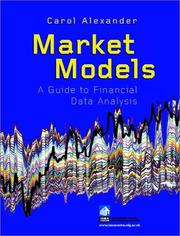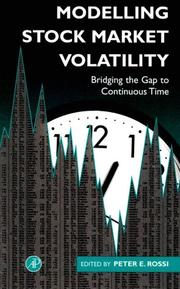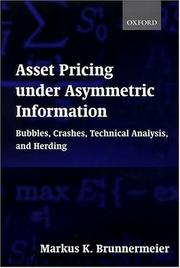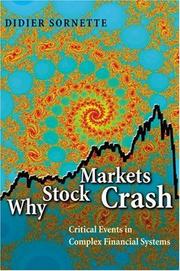| Listing 1 - 4 of 4 |
Sort by
|

ISBN: 0471899755 9780471899754 Year: 2001 Publisher: John Wiley,
Abstract | Keywords | Export | Availability | Bookmark
 Loading...
Loading...Choose an application
- Reference Manager
- EndNote
- RefWorks (Direct export to RefWorks)
Market Models provides an authoritative and up-to-date treatment of the use of market data to develop models for financial analysis. Written by a leading figure in the field of financial data analysis, this book is the first of its kind to address the vital techniques required for model selection and development. Model developers are faced with many decisions, about the pricing, the data, the statistical methodology and the calibration and testing of the model prior to implementation. It is important to make the right choices and Carol Alexander's clear exposition provides valuable insights at every stage. In each of the 13 Chapters, Market Models presents real world illustrations to motivate theoretical developments. The accompanying CD contains spreadsheets with data and programs; this enables the reader to implement and adapt many of the examples. The pricing of options using normal mixture density functions to model returns; the use of Monte Carlo simulation to calculate the VaR of an options portfolio; modifying the covariance VaR to allow for fat-tailed P&L distributions; the calculation of implied, EWMA and 'historic' volatilities; GARCH volatility term structure forecasting; principal components analysis; and many more are all included. Market Models: A Guide to Financial Data Analysis is the ideal reference for all those involved in market risk measurement, quantitative trading and investment analysis.
Stock price forecasting --- Portfolio management --- Mathematical models --- Mathematical models. --- AA / International- internationaal --- 305.91 --- 339.42 --- -Portfolio management --- -332.63222 --- Investment management --- Investment analysis --- Investments --- Securities --- Forecasting, Stock price --- Security price forecasting --- Stocks --- Business forecasting --- Econometrie van de financiële activa. Portfolio allocation en management. CAPM. Bubbles. --- Financiële analyse. --- Prices --- Forecasting --- 332.63222 --- Econometrie van de financiële activa. Portfolio allocation en management. CAPM. Bubbles --- Financiële analyse --- Stock price forecasting - Mathematical models --- Portfolio management - Mathematical models --- STOCK PRICE FORECASTING --- PORTFOLIO MANAGEMENT --- MATHEMATICAL MODELS --- MATHEMATHICAL MODELS

ISBN: 0125982755 9780125982757 9786612284823 1282284827 0080511872 9780080511870 Year: 1996 Publisher: San Diego : Academic Press,
Abstract | Keywords | Export | Availability | Bookmark
 Loading...
Loading...Choose an application
- Reference Manager
- EndNote
- RefWorks (Direct export to RefWorks)
This essay collection focuses on the relationship between continuous time models and Autoregressive Conditionally Heteroskedastic (ARCH) models and applications. For the first time, Modelling Stock Market Volatility provides new insights about the links between these two models and new work on practical estimation methods for continuous time models. Featuring the pioneering scholarship of Daniel Nelson, the text presents research about the discrete time model, continuous time limits and optimal filtering of ARCH models, and the specification and estimation of continuous time processes.
Stocks --- -332.63222 --- Common shares --- Common stocks --- Equities --- Equity capital --- Equity financing --- Shares of stock --- Stock issues --- Stock offerings --- Stock trading --- Trading, Stock --- Securities --- Bonds --- Corporations --- Going public (Securities) --- Stock repurchasing --- Stockholders --- Prices --- -Mathematical models --- -Electronic information resources --- E-books --- 336.763 --- -336.763 Effecten. Effectenbeurs. Stock-market. Risicodragend kapitaal. Aandelenkoers. Obligaties. Obligatiemarkt. --- Effecten. Effectenbeurs. Stock-market. Risicodragend kapitaal. Aandelenkoers. Obligaties. Obligatiemarkt. --- Continuous time. --- Mathematical models. --- 336.763 Effecten. Effectenbeurs. Stock-market. Risicodragend kapitaal. Aandelenkoers. Obligaties. Obligatiemarkt. --- Prices&delete& --- Mathematical models --- Effecten. Effectenbeurs. Stock-market. Risicodragend kapitaal. Aandelenkoers. Obligaties. Obligatiemarkt --- Investments --- Continuous time

ISBN: 0198296983 9780198296980 Year: 2001 Publisher: Oxford Oxford University Press
Abstract | Keywords | Export | Availability | Bookmark
 Loading...
Loading...Choose an application
- Reference Manager
- EndNote
- RefWorks (Direct export to RefWorks)
Capital assets pricing model. --- Information theory in economics. --- Stocks --- Prices. --- CAPM (finance) --- -Capital assets pricing model --- 332.63222 --- Capital asset pricing model --- CAPM (Capital assets pricing model) --- Pricing model, Capital assets --- Common shares --- Common stocks --- Equities --- Equity capital --- Equity financing --- Shares of stock --- Stock issues --- Stock offerings --- Stock trading --- Trading, Stock --- Stock repurchasing --- Capital assets pricing model --- Information theory in economics --- 336.76 --- Economic cybernetics --- Econometrics --- Capital --- Finance --- Investments --- 336.76 Beurswezen. Geldmarkt. Valutamarkt. Binnenlandse geldmarkt. Valutamarkt --- Beurswezen. Geldmarkt. Valutamarkt. Binnenlandse geldmarkt. Valutamarkt --- Stock prices --- Stockholder wealth --- Prices --- Mathematical models --- Money market. Capital market --- Stocks - Prices

ISBN: 0691096309 1400873126 9786612157400 0691118507 128215740X 1400829550 9780691118505 9780691096308 Year: 2009 Publisher: Princeton, NJ : Princeton University Press,
Abstract | Keywords | Export | Availability | Bookmark
 Loading...
Loading...Choose an application
- Reference Manager
- EndNote
- RefWorks (Direct export to RefWorks)
The scientific study of complex systems has transformed a wide range of disciplines in recent years, enabling researchers in both the natural and social sciences to model and predict phenomena as diverse as earthquakes, global warming, demographic patterns, financial crises, and the failure of materials. In this book, Didier Sornette boldly applies his varied experience in these areas to propose a simple, powerful, and general theory of how, why, and when stock markets crash. Most attempts to explain market failures seek to pinpoint triggering mechanisms that occur hours, days, or weeks before the collapse. Sornette proposes a radically different view: the underlying cause can be sought months and even years before the abrupt, catastrophic event in the build-up of cooperative speculation, which often translates into an accelerating rise of the market price, otherwise known as a "bubble." Anchoring his sophisticated, step-by-step analysis in leading-edge physical and statistical modeling techniques, he unearths remarkable insights and some predictions--among them, that the "end of the growth era" will occur around 2050. Sornette probes major historical precedents, from the decades-long "tulip mania" in the Netherlands that wilted suddenly in 1637 to the South Sea Bubble that ended with the first huge market crash in England in 1720, to the Great Crash of October 1929 and Black Monday in 1987, to cite just a few. He concludes that most explanations other than cooperative self-organization fail to account for the subtle bubbles by which the markets lay the groundwork for catastrophe. Any investor or investment professional who seeks a genuine understanding of looming financial disasters should read this book. Physicists, geologists, biologists, economists, and others will welcome Why Stock Markets Crash as a highly original "scientific tale," as Sornette aptly puts it, of the exciting and sometimes fearsome--but no longer quite so unfathomable--world of stock markets. Some images inside the book are unavailable due to digital copyright restrictions.
Stock exchanges --- Stocks --- Financial crises --- Complexity (Philosophy) --- Critical phenomena (Physics) --- History --- Prices --- -Stocks --- -Financial crises --- -Stock exchanges --- -Critical phenomena (Physics) --- 332.63222 --- Philosophy --- Emergence (Philosophy) --- Phenomena, Critical (Physics) --- Physics --- Bulls and bears --- Commercial corners --- Corners, Commercial --- Equity markets --- Exchanges, Securities --- Exchanges, Stock --- Securities exchanges --- Stock-exchange --- Stock markets --- Capital market --- Efficient market theory --- Speculation --- Crashes, Financial --- Crises, Financial --- Financial crashes --- Financial panics --- Panics (Finance) --- Stock exchange crashes --- Stock market panics --- Crises --- Business cycles --- Common shares --- Common stocks --- Equities --- Equity capital --- Equity financing --- Shares of stock --- Stock issues --- Stock offerings --- Stock trading --- Trading, Stock --- Securities --- Bonds --- Corporations --- Going public (Securities) --- Stock repurchasing --- Stockholders --- -History --- History. --- Phénomène critique (Physique) --- Phénomène critique (Physique) --- Critical phenomena (Physics). --- Stock exchanges. --- Forecasting. --- Mathematical models. --- Crises financières --- Bourse --- Histoire --- Modèles mathématiques --- Prévision --- Stock exchanges - United States - History --- Stocks - Prices - History --- Financial crises - United States - History --- Financial crises - History
| Listing 1 - 4 of 4 |
Sort by
|

 Search
Search Feedback
Feedback About UniCat
About UniCat  Help
Help News
News